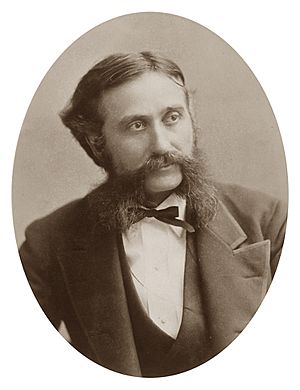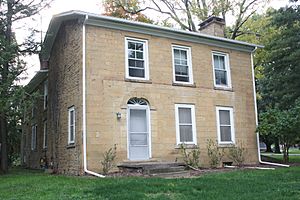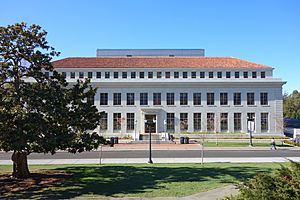Hubert Howe Bancroft facts for kids
Quick facts for kids
Hubert Howe Bancroft
|
|
|---|---|
 |
|
| Born | May 5, 1832 |
| Died | March 2, 1918 (aged 85) |
| Occupation | Historian |
| Known for | Early histories of the North American west |
| Signature | |
Hubert Howe Bancroft (born May 5, 1832 – died March 2, 1918) was an American historian. He was also an ethnologist, which means he studied different cultures and peoples.
Bancroft wrote, published, and collected many books. His works focused on the history of the western United States. This included areas like Texas, California, Alaska, Mexico, Central America, and British Columbia.
Contents
Early Life and Beginnings
Hubert Howe Bancroft was born on May 5, 1832, in Granville, Ohio. His parents were Azariah Ashley Bancroft and Lucy Howe Bancroft. Their families came from the New England states of Vermont and Massachusetts.
Bancroft's parents were strong abolitionists. This means they were against slavery and worked to end it. Their family home was even a stop on the Underground Railroad. The Underground Railroad was a secret network that helped enslaved people escape to freedom.
Bancroft went to Doane Academy in Granville for one year. After that, he started working as a clerk. He worked in his brother-in-law's bookstore in Buffalo, New York.
Moving to California
In March 1852, Bancroft moved to San Francisco, California. He was sent there with books to sell. His job was to open a new office for his brother-in-law's company on the West Coast.
San Francisco was a fast-growing city at that time. Bancroft was very successful in building his business. He also started his own publishing company. During this time, he became a serious collector of books. His collection grew to tens of thousands of books!
In 1868, Bancroft left his business to his brother, A. L. Bancroft. He had gathered a huge library of historical materials. He decided to stop working in business. Instead, he wanted to spend all his time writing and publishing history books.
Bancroft's library included books, maps, and many printed and handwritten documents. It also had stories told by pioneers, settlers, and important leaders. These stories were written down by Bancroft or his helpers. It took six people ten years to organize and index this huge collection. In 1881, the library was moved to a special fireproof building. By 1900, it had about 45,000 books.
He planned to publish a 39-volume history series. This series would cover the entire Pacific coast region of North America. It would stretch from Central America all the way to Alaska. He hired other writers to help him. He also wrote some parts himself. However, he only put his own name as the author. In 1886, the publishing company of A. L. Bancroft & Company burned down. This fire destroyed parts of seven volumes of the history he had written.
Personal Life
Bancroft married Emily Ketchum in 1859. They had one daughter, Kate, who was born in 1859. Sadly, Emily died in childbirth in 1869.
Bancroft married again in 1879. His second wife was Matilda Coley Griffing. They had four children together.
Even though he never finished college, Bancroft received an important award. In 1875, Yale gave him an honorary Master of Arts degree. This was to recognize his huge historical work called Native Races of the Pacific States. He also became a member of the American Antiquarian Society in 1875.
Death
Hubert Howe Bancroft died on March 2, 1918. He passed away at his home in Walnut Creek, California. Newspaper reports said he died from "acute peritonitis." He was 85 years old when he died. His body was buried in the Cypress Lawn Memorial Park in Colma, California.
Legacy and Impact
Later in the 1800s, some people realized that much of the work Bancroft claimed to have written was actually written by others. This made some scholars question his work. The Salt Lake Tribune newspaper even called him a "purloiner of other peoples' brains" in 1893. This means they thought he stole other people's ideas.
The Bancroft Library at UC Berkeley is named after him. The University of California bought his collection of 60,000 books in 1905. Also, Bancroft Way in Berkeley, California, is named in his honor.
In 1885, Bancroft bought a ranch in Spring Valley, in San Diego County. He planned to use the adobe cottage there as a retirement home. Today, the Hubert H. Bancroft Ranch House is a National Historic Landmark. This means it's a very important historical place.
Also, part of a property Bancroft bought around 1880 in Contra Costa County, California later became the Ruth Bancroft Garden. This happened when Bancroft's grandson, Philip, gave three acres of the farm land to his wife, Ruth Bancroft.
Several schools are named after Bancroft. These include:
- Bancroft Middle School (Long Beach, California)
- Bancroft Middle School (Los Angeles, California)
- Hubert H. Bancroft Elementary School in Sacramento
- Bancroft Elementary School in Andover, Massachusetts
- Bancroft Community School in Spring Valley, California
An archive of letters from the Bancroft family is kept at the Geisel Library at the University of California, San Diego. This collection was put together by his daughter, Kate.
An oral history interview with Margaret Wood Bancroft is also available. She was the widow of Bancroft's son, Griffing. This interview is kept at the Bancroft Library at the University of California, Berkeley.
Published Works
Bancroft wrote many books. His most famous work is the 39-volume set called The Works of Hubert Howe Bancroft (published from 1874–1890).
Some of his other written works include:
- The Early American Chroniclers (1883)
- Chronicles of the Builders of the Commonwealth: Historical Character Study (1891–1892)
- Book of the Fair (1893)
- Resources and Development of Mexico (1893)
- The Book of Wealth (1896)
- The New Pacific (1912)
- Retrospection, Political and Personal (1912, 1915)
- Why a World Centre of Industry at San Francisco Bay (1916)
- In These Latter Days (1917)
How He Produced His Books
Bancroft used index cards to organize facts for his many history books. He also had many research assistants helping him. Some of these assistants contributed so much that they were almost like co-writers.
At first, Bancroft planned to use the sections written by his assistants as a base. Then, he would write the main story himself. But as the work continued, he started using their writings almost as they were, with only small changes. He believed his assistants were good researchers. For example, Frances Fuller Victor was a well-known author who helped him.
However, Bancroft did not always give credit to each person who helped him. This made some people doubt the quality of his work. While Bancroft saw himself as the author, today it's more accurate to think of him as an editor and someone who put the information together.
Bancroft and most of his assistants were not formally trained historians. So, they sometimes included their own opinions. But generally, their books were well-liked at the time. Historian Francis Parkman praised Bancroft's The Native Races. However, Lewis H. Morgan was more critical. He wrote an article called Montezuma's Dinner based on his new ideas about Native American culture. Bancroft's response to Morgan suggests he didn't fully understand Morgan's theory, which is now widely accepted by scholars.
See also
 In Spanish: Hubert Howe Bancroft para niños
In Spanish: Hubert Howe Bancroft para niños




